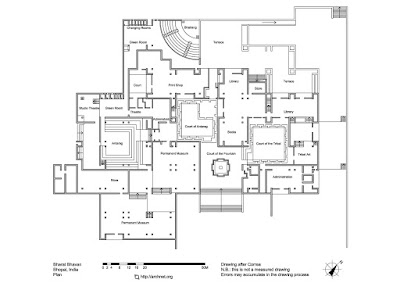Tuesday, March 24, 2020
Monday, March 23, 2020
City Centre Mall, Kolkata
This writing is an excerpt from an old essay written in 2007. The writing has been amended for brevity here.
--
The City Centre, Kolkata, one of the latter projects of the architect Charles Correa (completed in 2004), was conceived as a convergence of functionality and aesthetics. The architect has tried to bring in the organic nature in the shopping mall by an innovative re-interpretation of an Indian market. Instead of bringing up a large chunk of building on an otherwise large land, the City Centre has been broken up into smaller fragments of forms interlinked by small bridges, courtyards and semi open spaces. Such a strategy not only makes the mall environmentally friendly, but also develops a character which is so typical of any Indian bazaar.
The idea of mall being an introvert, closed environment has been deconstructed and the place has been developed as porous organization of simple forms. On entering, the architect decides to give multiple experiences to the user by placing a kund and taking the user upwards through a flight of steps to create a sense of ghat, which traditionally has been a meeting place for people in Kolkata. The culmination of the experience of the entrance is its dissolution into the numerous streets of the bazaar. The public spaces within the otherwise conditioned space of the mall have been brought out in the open, which users can occupy and make their own personal zones. During larger public events, these smaller zones accrue to become one large theatre.
While going across th bazaar-streets within the mall, one is introduced to the sudden arrival of courtyards, appropriately scaled down to relate to the human level. The eateries are allowed to spread onto these ‘streets‘ as would normally happen in a khau galli. The interesting patterns of routes that the people make from between all such activities can be seen from strategically created levels which connect the inside and outside.
The City Centre does not define itself by creating boundaries, but itself goes and meets its surroundings. Different parts of the complex are taken up for various activities during festivals, seasonal exhibitions or public awareness. The City Centre thus assumes a truly public character and almost becomes an icon, not visually, but notionally, through the multiple experiences its offers to visitors. It balances the public and private interests of the larger society and dissolves class boundaries through intelligent design. People from all walks of life visit the mall without hesitation, rather it has given a new identity to the once socially relegated area of Kolkata.
--
The City Centre, Kolkata, one of the latter projects of the architect Charles Correa (completed in 2004), was conceived as a convergence of functionality and aesthetics. The architect has tried to bring in the organic nature in the shopping mall by an innovative re-interpretation of an Indian market. Instead of bringing up a large chunk of building on an otherwise large land, the City Centre has been broken up into smaller fragments of forms interlinked by small bridges, courtyards and semi open spaces. Such a strategy not only makes the mall environmentally friendly, but also develops a character which is so typical of any Indian bazaar.
The idea of mall being an introvert, closed environment has been deconstructed and the place has been developed as porous organization of simple forms. On entering, the architect decides to give multiple experiences to the user by placing a kund and taking the user upwards through a flight of steps to create a sense of ghat, which traditionally has been a meeting place for people in Kolkata. The culmination of the experience of the entrance is its dissolution into the numerous streets of the bazaar. The public spaces within the otherwise conditioned space of the mall have been brought out in the open, which users can occupy and make their own personal zones. During larger public events, these smaller zones accrue to become one large theatre.
While going across th bazaar-streets within the mall, one is introduced to the sudden arrival of courtyards, appropriately scaled down to relate to the human level. The eateries are allowed to spread onto these ‘streets‘ as would normally happen in a khau galli. The interesting patterns of routes that the people make from between all such activities can be seen from strategically created levels which connect the inside and outside.
The City Centre does not define itself by creating boundaries, but itself goes and meets its surroundings. Different parts of the complex are taken up for various activities during festivals, seasonal exhibitions or public awareness. The City Centre thus assumes a truly public character and almost becomes an icon, not visually, but notionally, through the multiple experiences its offers to visitors. It balances the public and private interests of the larger society and dissolves class boundaries through intelligent design. People from all walks of life visit the mall without hesitation, rather it has given a new identity to the once socially relegated area of Kolkata.
Sunday, March 22, 2020
Friday, March 20, 2020
Tuesday, March 17, 2020
Subscribe to:
Posts (Atom)









